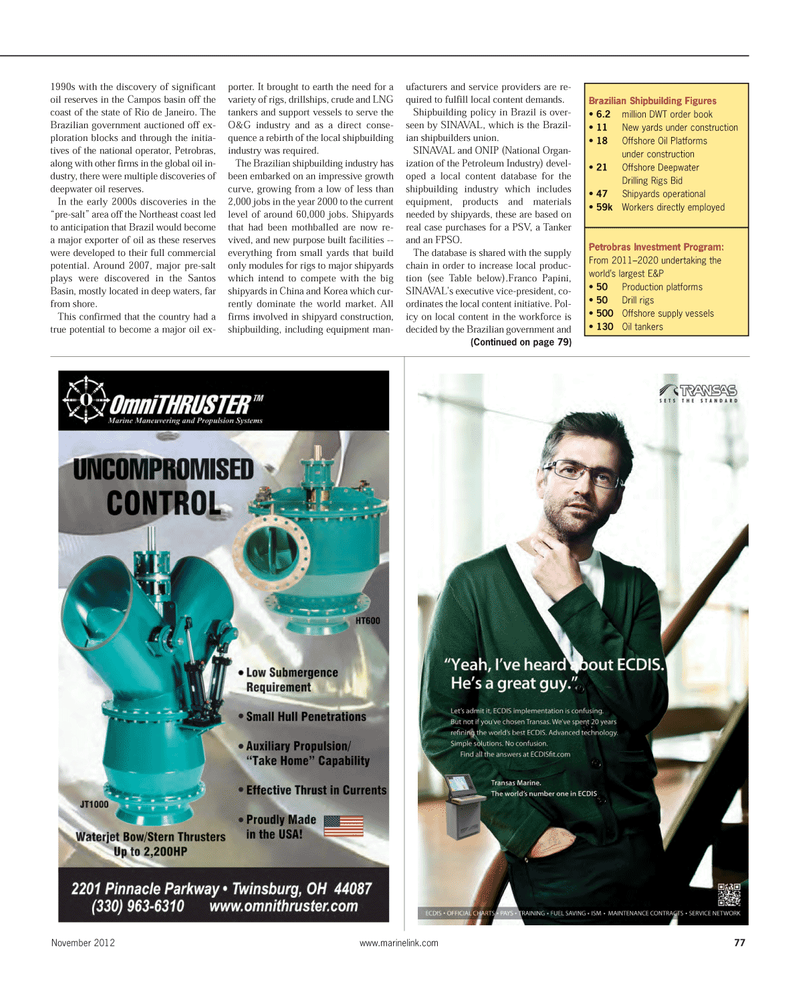
Page 77: of Maritime Reporter Magazine (November 2012)
Workboat Annual
Read this page in Pdf, Flash or Html5 edition of November 2012 Maritime Reporter Magazine
November 2012www.marinelink.com 771990s with the discovery of significant oil reserves in the Campos basin off the coast of the state of Rio de Janeiro. The Brazilian government auctioned off ex- ploration blocks and through the initia-tives of the national operator, Petrobras, along with other firms in the global oil in- dustry, there were multiple discoveries of deepwater oil reserves. In the early 2000s discoveries in the ?pre-salt? area off the Northeast coast led to anticipation that Brazil would become a major exporter of oil as these reserves were developed to their full commercial potential. Around 2007, major pre-salt plays were discovered in the Santos Basin, mostly located in deep waters, far from shore. This confirmed that the country had a true potential to become a major oil ex- porter. It brought to earth the need for a variety of rigs, drillships, crude and LNG tankers and support vessels to serve the O&G industry and as a direct conse-quence a rebirth of the local shipbuilding industry was required. The Brazilian shipbuilding industry has been embarked on an impressive growth curve, growing from a low of less than 2,000 jobs in the year 2000 to the currentlevel of around 60,000 jobs. Shipyards that had been mothballed are now re- vived, and new purpose built facilities -- everything from small yards that build only modules for rigs to major shipyards which intend to compete with the bigshipyards in China and Korea which cur- rently dominate the world market. All firms involved in shipyard construction, shipbuilding, including equipment man- ufacturers and service providers are re- quired to fulfill local content demands. Shipbuilding policy in Brazil is over- seen by SINAVAL, which is the Brazil- ian shipbuilders union. SINAVAL and ONIP (National Organ- ization of the Petroleum Industry) devel- oped a local content database for theshipbuilding industry which includes equipment, products and materialsneeded by shipyards, these are based on real case purchases for a PSV, a Tanker and an FPSO. The database is shared with the supplychain in order to increase local produc-tion (see Table below).Franco Papini, SINAVAL?s executive vice-president, co- ordinates the local content initiative. Pol- icy on local content in the workforce is decided by the Brazilian government and Brazilian Shipbuilding Figures 6.2 millionDWT order book 11New yards under construction 18 Offshore Oil Platforms under construction 21Offshore Deepwater Drilling Rigs Bid 47Shipyards operational 59kWorkers directly employed Petrobras Investment Program: From 2011?2020 undertaking the world?s largest E&P 50 Production platforms 50Drill rigs 500Offshore supply vessels 130Oil tankers(Continued on page 79)MR#11 (74-81):MR Template 11/6/2012 8:15 AM Page 77

 76
76

 78
78
